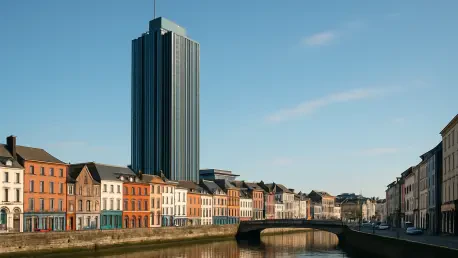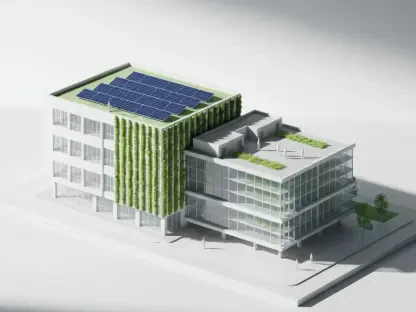Cork, Ireland, stands at the threshold of a remarkable urban transformation with the recent approval of two groundbreaking housing projects that promise to redefine the city’s skyline and tackle a persistent housing crisis. Named Railyard Gardens and Creamfields, these developments will collectively deliver 832 social and cost-rental homes, addressing a critical need for affordable living spaces in a rapidly growing urban center. This achievement marks a significant milestone for Cork, reflecting a forward-thinking approach to urban planning that balances architectural ambition with social responsibility. The collaboration between Cork City Council, national government bodies, housing associations, and private developers showcases a unified effort to meet the demands of a diverse population. As local leaders express optimism about the potential impact, these projects signal a new chapter for the city, one focused on building not just homes, but vibrant, inclusive communities that can thrive in a modern urban landscape.
Project Highlights
Railyard Gardens: Ireland’s Tallest Tower
Architectural Milestone and Housing Innovation
Railyard Gardens, located at the historic Albert Quay/Albert Street site in Cork, is set to make history with its 24-story tower, which will claim the title of Ireland’s tallest building. Accompanied by adjacent structures stepping down to 12 and 9 floors, this development will provide 217 cost-rental apartments, with rents designed to be at least 25% below market rates. This pricing structure aims to make housing accessible to a broad demographic, ensuring that young professionals and small families can afford to live in the heart of the city. Beyond its impressive height, the project represents a bold vision for urban living, prioritizing density and efficiency in a space-constrained environment. The architectural design not only pushes boundaries but also serves as a symbol of Cork’s aspirations to compete on a national scale, blending aesthetic innovation with practical housing solutions that address real community needs.
Community Focus and Inclusive Features
Beyond its towering presence, Railyard Gardens stands out for its commitment to inclusivity and social impact, catering to a wide range of residents with tailored housing options. Up to 50 of the apartments are specifically designed for older individuals and those with disabilities, ensuring that accessibility remains a cornerstone of the development. Additionally, ground-floor spaces have been allocated for community and arts use, fostering a sense of connection and cultural engagement among residents. This thoughtful integration of social spaces highlights a broader goal of creating a neighborhood that goes beyond mere shelter, encouraging interaction and creativity. By addressing the diverse needs of its future inhabitants, Railyard Gardens sets a precedent for how urban housing can balance individual requirements with collective well-being, making it a model for future projects in Cork and beyond.
Creamfields: Massive Social Housing Push
Unprecedented Scale to Combat Housing Shortage
Creamfields, situated on Tramore Road, emerges as the largest social housing project in Cork’s history, with plans to deliver approximately 606 new homes to address the city’s acute housing shortage. Spearheaded by Cairn Homes Plc in collaboration with Respond Housing and Dairygold, this ambitious initiative represents a monumental effort to provide shelter for those most in need. The sheer scale of the project underscores the urgency of the housing crisis, as well as the determination to find large-scale solutions that can make a tangible difference. By focusing on social housing, Creamfields targets vulnerable populations and low-income families, ensuring that growth in Cork does not leave behind those who struggle to secure affordable accommodation. This development stands as a testament to the city’s commitment to equity, prioritizing volume and accessibility in its urban planning strategy.
Strategic Placement for Seamless Integration
The strategic location of Creamfields on Tramore Road plays a pivotal role in its potential to reshape urban living in Cork, ensuring that residents are well-connected to essential infrastructure and services. Positioned to integrate seamlessly into the city’s existing fabric, the site offers proximity to transport links and amenities, making daily life more convenient for future occupants. This emphasis on accessibility reflects a broader understanding of what makes a community livable, as it reduces the need for lengthy commutes and supports a more balanced lifestyle. Moreover, the location enhances the project’s ability to contribute to the city’s growth, linking new residents with employment opportunities and social resources. By prioritizing connectivity, Creamfields demonstrates how thoughtful urban design can amplify the impact of housing initiatives, creating environments where people can thrive without the burden of isolation or inaccessibility.
Key Themes in Urban Development
Addressing the Housing Crisis
Innovative Responses to Urgent Needs
The housing crisis in Cork has reached a critical point, and both Railyard Gardens and Creamfields represent innovative, large-scale responses aimed at alleviating this pressing issue. By delivering a combined total of 832 social and cost-rental homes, these projects target a wide spectrum of residents, from low-income families to young professionals seeking affordable urban living. The focus on below-market rents and social housing units ensures that economic barriers do not exclude individuals from accessing quality accommodation. This approach acknowledges the diverse financial challenges faced by the population, offering a lifeline to those who might otherwise struggle in a competitive housing market. As cities across Ireland grapple with similar shortages, Cork’s proactive stance through these developments highlights a potential path forward, emphasizing scale and affordability as key pillars of urban progress.
Power of Collaborative Partnerships
A defining feature of these housing projects is the collaborative framework that underpins their execution, bringing together Cork City Council, national government departments, housing bodies, and private developers. This multi-stakeholder approach leverages public oversight with private investment, ensuring that resources and expertise are maximized for the benefit of the community. Such partnerships have become increasingly vital in addressing complex urban challenges, as they distribute responsibility and risk while fostering innovation. The involvement of entities like Clúid Housing and Cairn Homes Plc alongside local authorities illustrates how shared goals can drive ambitious outcomes, creating a synergy that benefits all parties. This model of teamwork not only accelerates project delivery but also serves as a blueprint for other regions facing housing dilemmas, demonstrating the effectiveness of unity in urban development.
Sustainability and Modern Design
Embracing Eco-Friendly Urban Living
Sustainability takes center stage in the design of Railyard Gardens, where the deliberate omission of resident parking spaces signals a shift toward eco-friendly urban lifestyles. Instead, provisions for bicycles and personal mobility aids like electric scooters encourage alternative transportation methods, reducing reliance on cars and lowering carbon emissions. This forward-thinking decision aligns with global efforts to combat climate change through smarter city planning, prioritizing environmental health alongside resident needs. By embedding such features into the heart of the development, Cork sets an example of how housing can contribute to broader sustainability goals, creating spaces that support both people and the planet. This focus on green living reflects a growing awareness of the need to adapt urban environments to pressing ecological challenges, ensuring long-term viability.
Vertical Growth as a Space Solution
The trend of vertical urbanization, exemplified by Railyard Gardens’ 24-story tower, addresses the challenge of limited land availability in densely populated areas like Cork. Building upward allows cities to accommodate growing populations without sprawling outward, preserving surrounding green spaces and reducing urban sprawl. This strategy, while innovative, also redefines the visual identity of a city, with towering structures becoming symbols of progress and ambition. The architectural push to create Ireland’s tallest building speaks to a broader movement in urban design, where height becomes a practical solution to spatial constraints. However, it also underscores the importance of balancing density with livability, ensuring that high-rise environments remain human-centered. As more cities adopt this approach, Cork’s experience with vertical expansion offers valuable insights into maximizing space while maintaining quality of life.
Importance of Accessibility
Building Connected Urban Spaces
Accessibility emerges as a cornerstone of both Railyard Gardens and Creamfields, with their strategic locations near transport hubs and key infrastructure ensuring residents remain connected to the city’s pulse. This deliberate placement minimizes the need for private vehicle use, promoting public transport and fostering a more integrated urban experience. For residents, this means easier access to jobs, schools, and healthcare, which are essential components of a functional community. By prioritizing connectivity, these projects contribute to a vision of Cork as a city where mobility does not come at the cost of equity or convenience. This focus aligns with modern urban planning principles that seek to create seamless networks of movement, enhancing the daily lives of citizens while supporting sustainable growth patterns across the region.
Holistic Planning for Community Well-Being
Beyond mere location, the design of these developments reflects a holistic approach to urban planning, where housing serves as a foundation for broader community well-being. Features like community and arts spaces in Railyard Gardens emphasize the creation of environments where social bonds can flourish, while Creamfields’ scale ensures that entire neighborhoods can emerge with shared resources. This perspective recognizes that successful cities are not just collections of buildings but ecosystems where people interact, grow, and support one another. By weaving accessibility and social infrastructure into the fabric of these projects, Cork demonstrates a commitment to livability that transcends basic shelter. Looking back, the approval of these initiatives marked a turning point, as they laid the groundwork for a future where urban spaces were shaped by a deep understanding of human needs, offering a model for sustainable and inclusive growth.









